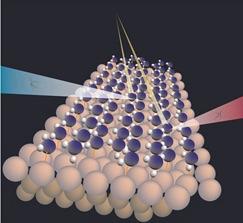X-ray absorption spectroscopy provides a fingerprint of the molecular orbital structure of interfacial water that is affected by the local hydrogen-bonding network.
The structure of water at solid interfaces is, even at ambient temperatures, often believed to be ice-like with highly tetrahedral order due to a strong templating effect from the surface. Here a new phase of water next to the interface is observed which is typical of what is expected if extremely high pressures are applied to bulk water which instead breaks up the tetrahedral nature.
Water is unique in that it exists in several different identifiable amorphous forms, low-density amorphous (LDA) ice, high-density (HDA) amorphous ice, and very-high-density amorphous (VHDA) ice with a density difference of 33% between LDA and VHDA. There are many crystalline phases that resemble some of the amorphous forms, but much higher density ices can also be generated under pressure; e.g., ice VII has a density 74 % higher than hexagonal ice Ih. All of these crystalline ice phases formed at modestly high pressures, as well as amorphous or glassy water, typically have structures in which there is an inward collapse of the second coordination shell.
The structure of thin-film water on a BaF2(111) surface was studied using x-ray absorption spectroscopy from ambient to supercooled temperatures at relative humidity up to 95 %. The spectrum of liquid thin-film water on BaF2 exhibits, at all temperatures, a strong resemblance to that of high-density ices for which the observed spectroscopic features correlate linearly with the density. It is surprising that the BaF2(111) surface does not act as an ice formation template for ambient and supercooled water films, notwithstanding the close lattice match. Molecular dynamics simulations indicate that the first layer water on BaF2(111) is indeed in a unique local structure that resembles high-density water, a liquid form of HDA, with a strongly collapsed second coordination shell. These results indicate that water close to the interface is transformed into a highly compressed structure typically otherwise only seen upon applying modest pressure of the liquid.

